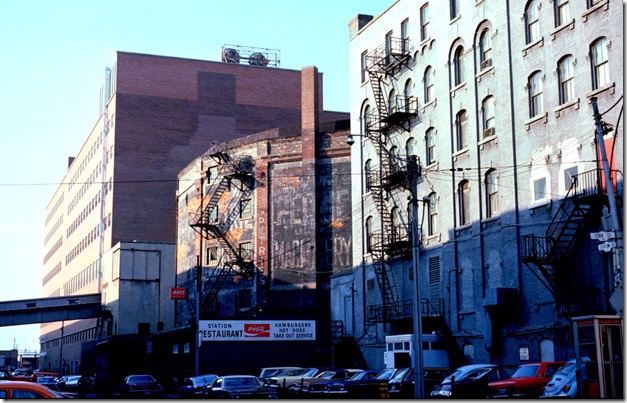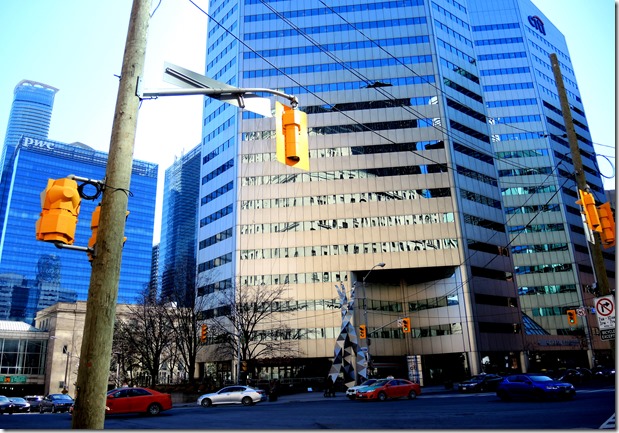In the foreground is the building that once housed Toronto’s Cyclorama, on Front Street West. The photo was taken c. 1975, the year prior to its demolition. The Walker House (Hotel) is to the east (left) of the Cyclorama and the Swiss Bear Restaurant (with the pointed roof) is between the two structures. Both of these have also been demolished. In the distance (far left) is today’s Union Station. Toronto Archives, F0124, fl. 0003, id. 0057.
When I was a teenager in the 1950s, Front Street as depicted in the above photo was very familiar to me. I drove or walked past this section of the street many times, but knew very little about the history of the rather strange looking parking garage that was circular in shape. My father had told me that it had once contained some sort of enormous painting, which encircled its interior. However, he knew nothing more about the structure. It was built long before he arrived in the city in 1921, and he had never been inside it.
I did not pursue the matter any further, as being a teenager I was busy with other things. In my mind, it remained simply an odd-shaped parking garage that was quite ugly, and thus I did not take much notice when I heard that it was being demolished. However, when researching the cyclorama for this post, I discovered that it was once an important part of Toronto’s entertainment scene.
Cycloramas were popular in the final decades of the nineteenth century as they presented dramatic scenes in blazing colours. Photography was in its infancy and there were no coloured photographs other than those that were hand-tinted. The only way of depicting colourful scenery or important events was by creating paintings with oils or watercolours. As a result, in the 1880s, in Europe and North America, large buildings were constructed to display huge 360 degree canvases. They wrapped around the interior of the structures and viewers stood on stages in the centre of the paintings or on walkways. Erected for public entertainment, these buildings were named cycloramas because they were cylindrical in shape.
Toronto’s Cyclorama was typically round in appearance, similar to others world-wide. However, it actually possessed 16 flat sides, the resulting hexadecagon looking like an enormous circle. It was a combination of an art gallery and an amusement arcade. Around the interior of the brick building, which was the equivalent of three storeys in height, in which multiple canvases were connected to create a 400-foot continuous scene. The painting was 50 feet high, the dome above it coloured to resemble the sky. Created by an Austrian artist, August Lohr, the perspective was increased to simulate a 3D effect. Erected by the Toronto Art Exhibition Company Ltd., the building’s architects were Kennedy and Holland. It was located on the south side of Front Street West, between York and Simcoe Streets. The old Union Station (now demolished), was immediately to the south of it.
When Toronto’s cyclorama opened on September 13, 1887, it was a colourful and amazing sight for 19th-century visitors. The first presentation was a panoramic view of the Battle of Sedan, one of the bloodiest battles of the Franco Prussian War of the 1870s. In front of the the scene were real and manufactured artefacts (weapons, uniforms , a real horse that was stuffed, a cannon, etc.). To add realism, at peak viewing times costumed actors portrayed soldiers, sound effects were added, and sometimes smoke to simulate the after effects of cannon fire. Visitors paid 25 cents to enter the building, and viewed the art work from a walkway that allowed them to move around the entire circle. The concept was a great success.
In 1889, the Battle of Gettysburg was shown at the cyclorama. Then, the Battle of Waterloo was the subject, and next, Jerusalem on the Day of the Crucifixion. Historic and religious themes were the favourites of cycloramas in Europe as well as in North America.
However, as the 20th century approached, technology continued to advance and magic lantern shows (slides) began to reproduce authentic scenes of nature, cities, and even important events. These were followed by silent movies that were often filmed on real locations. Attendance at cycloramas throughout the world slowly declined.
Toronto’s cyclorama was seized by the City of Toronto about the year 1898, for non-payment of $2095 in taxes. It remained empty for many years, and was in danger of being demolished. Finally, in 1927, it was purchased by the Petrie Machinery Company for a showroom and factory. A few years later, it was remodelled to create a parking garage for the nearby Royal York Hotel, which opened in June, 1929. The conversion of the cyclorama into a garage presented many engineering problems. In the 1940s, the cyclorama became a showroom for Elgin Motors, and finally, a parking garage for Avis Car Rentals.
In 1976, the cyclorama was purchased, and along with the Walker House Hotel, was demolished to erect Citigroup Place. Today, when I drive southbound on York Street to reach the Gardiner Expressway, at Front Street I often think of the old Walker House and Toronto’s Cyclorama.
Site of Toronto’s Cyclorama.
Postcard from 1906, depicting the cyclorama when it was the Petrie Machinery Emporium. The view is from Front Street, the old Union Station erected in 1873, to the west of it. All these buildings have been demolished. Image from skritch.blogspot.com
The cyclorama in 1922, when it was the Petrie Machinery Company showroom and factory. Toronto Archives, F1244, Item 1099.
The dome of the cyclorama on December 6, 1923. Toronto Archives, F1548, S0393, Item 20964.
This photo was taken on June 3, 1926. It gazes toward the northwest, the three towers of the Union Station, erected in 1873, on the left-hand side. The taller tower to the north of the three towers is the section of the station on Front Street. The south and east sides of the cyclorama are visible, as well as the Walker House beside it, on the east side. The bridge crossing over the railway tracks is on York Street. Toronto Archives, F1580, Item 0017.
This panoramic view gazes at the south (rear) and east sides of the cyclorama, the Walker House to the east of it. York Street is between the Walker House and Union Station, which opened in 1927. Front Street is on the north side of the buildings. The Queen’s Hotel, where the Royal York Hotel is today, is across from Union Station. The clock tower of the Old City Hall is in the upper left-hand corner. Photo was taken c.1927, and is from the collection of the Toronto Archives, F1231, Item 0100 (1).
Split image depicting the cyclorama in the 1940s (left) and a sketch of the cyclorama in the late-19th century. Image from www.BlogTo.com
Undated photo of the interior of the cyclorama, when floors had been built inside it to convert it into a parking garage. Image from pinterest.com.
View of the north (front) side of the cyclorama on Front Street in 1953, the Walker House to the east of it. Toronto Public Library r-3686.
The south side of the cyclorama and the Walker House (foreground) on January 7, 1975. View gazes west on Station Street from York Street. Toronto Archives, F1526, Fl 0051, Item 0001
The site where the cyclorama and the Walker House were located, on Front Street to the west of York Street. Photo taken in March 2016.
A link to discover more about the old Walker House Hotel to the east of the cyclorama:
https://tayloronhistory.com/2016/04/12/walker-house-hotel-demolished-front-and-york-streets/
To view the Home Page for this blog: https://tayloronhistory.com/
For more information about the topics explored on this blog:
https://tayloronhistory.com/2016/03/02/tayloronhistory-comcheck-it-out/
The publication entitled, “Toronto’s Theatres and the Golden Age of the Silver Screen,” was written by the author of this blog. It explores 50 of Toronto’s old theatres and contains over 80 archival photographs of the facades, marquees and interiors of the theatres. It relates anecdotes and stories by the author and others who experienced these grand old movie houses.
To place an order for this book:
Book also available in Chapter/Indigo, the Bell Lightbox Book Shop, and by phoning University of Toronto Press, Distribution: 416-667-7791 (ISBN 978.1.62619.450.2)
Another book, published by Dundurn Press, containing 80 of Toronto’s former movie theatres will be released in June, 2016. It is entitled, “Toronto’s Movie Theatres of Yesteryear—Brought Back to Thrill You Again.” It contains over 125 archival photographs and relates interesting anecdotes about these grand old theatres and their fascinating histories.
Another publication, “Toronto Then and Now,” published by Pavilion Press (London, England) explores 75 of the city’s heritage sites. This book will be released in June 2016. For further information follow the link to Amazon.com here or contact the publisher directly by the link shown below:
http://www.ipgbook.com/toronto–then-and-now—products-9781910904077.php?page_id=21.
![f0124_fl0003_id0058[1] f0124_fl0003_id0058[1]](https://tayloronhistory.com/wp-content/uploads/2016/04/f0124_fl0003_id00581_thumb.jpg)
![skritchblogspot.com Petriecyclorama-emporium1906[1] skritchblogspot.com Petriecyclorama-emporium1906[1]](https://tayloronhistory.com/wp-content/uploads/2016/04/skritchblogspot-com-petriecyclorama-emporium19061_thumb.jpg)

![Dec. 6, 1926 f1548_s0393_it20964[1] Dec. 6, 1926 f1548_s0393_it20964[1]](https://tayloronhistory.com/wp-content/uploads/2016/04/dec-6-1926-f1548_s0393_it209641_thumb.jpg)
![1926, f1580_it0017[1] 1926, f1580_it0017[1]](https://tayloronhistory.com/wp-content/uploads/2016/04/1926-f1580_it00171_thumb.jpg)
![f1231_it0100[1] f1231_it0100[1]](https://tayloronhistory.com/wp-content/uploads/2016/04/f1231_it01001_thumb.jpg)
![201216-cyclorama-splitfrom BlogTo [1] 201216-cyclorama-splitfrom BlogTo [1]](https://tayloronhistory.com/wp-content/uploads/2016/04/201216-cyclorama-splitfrom-blogto-1_thumb.jpg)
![pinterest.com 57d71de398cd8e5a3b93f277b5d4866e[1] pinterest.com 57d71de398cd8e5a3b93f277b5d4866e[1]](https://tayloronhistory.com/wp-content/uploads/2016/04/pinterest-com-57d71de398cd8e5a3b93f277b5d4866e1_thumb.jpg)
![1953, pictures-r-3686[1] 1953, pictures-r-3686[1]](https://tayloronhistory.com/wp-content/uploads/2016/04/1953-pictures-r-36861_thumb.jpg)


![cid_E474E4F9-11FC-42C9-AAAD-1B66D852[1] cid_E474E4F9-11FC-42C9-AAAD-1B66D852[1]](https://tayloronhistory.com/wp-content/uploads/2016/04/cid_e474e4f9-11fc-42c9-aaad-1b66d8521_thumb1.jpg)
![image_thumb6_thumb_thumb_thumb_thumb[1] image_thumb6_thumb_thumb_thumb_thumb[1]](https://tayloronhistory.com/wp-content/uploads/2016/04/image_thumb6_thumb_thumb_thumb_thumb1_thumb2.png)



Hello Mr. Taylor,
I was wondering if your books about the Walkerhouse Hotel and Toronto Theatres (cinemas) are available in bookstores in Toronto.
I live in Germany, but grew up in Toronto. Our first “home” when we moved to Toronto was the Walkerhouse Hotel and I worked 13 years (until 1988) for Famous Players Ltd. as mgr. in practically all theatres in Toronto.
I would be grateful to hear from you.